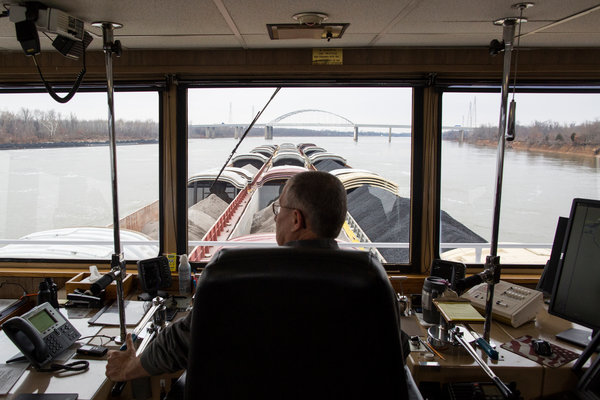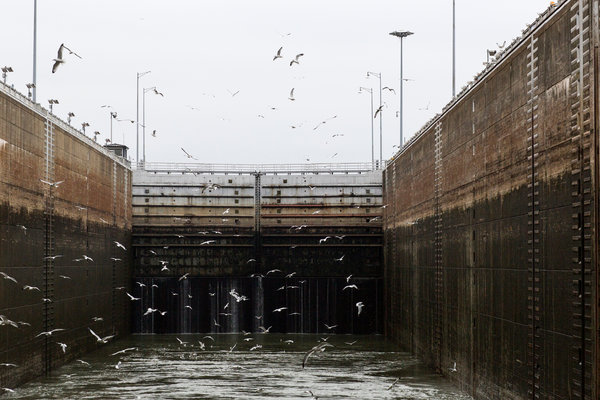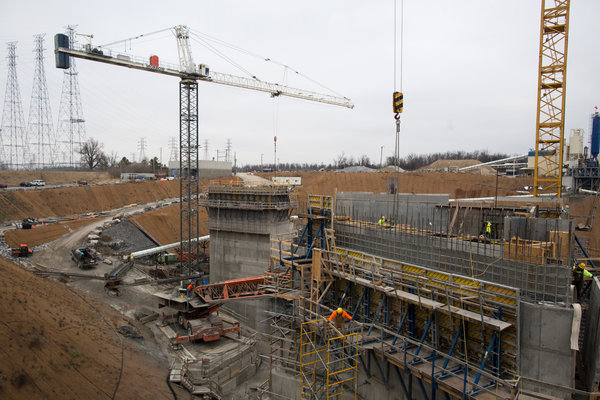Barges Sit for Hours Behind Locks That May Take Decades to
Replace
NY Times
4 February 2015
By Ron Nixon

Randy Holt piloting the boat Bill Berry out of
the lock system at Kentucky Lock and Dam near Paducah, Ky., last
month. Credit Joe Buglewicz for The New York Times
PADUCAH, Ky. — On a recent winter morning, Randy Holt piloted
the boat Bill Berry as it pushed a group of barges nearly as long
as two football fields steadily down the Tennessee River to the
Kentucky Lock and Dam here. But then Mr. Holt had to wait several
hours at what has become a major choke point as boats moved one at
a time through the narrow, cracked, 70-year-old lock.
“Sometimes, we get here in the mornings and won’t leave until late
into the night,” Mr. Holt said.
Locks are intended to make it easy for the Bill Berry and barges,
with their cargoes of grain, coal and oil, to navigate the uneven
waters of the Mississippi, Kentucky and Ohio Rivers.
But largely out of sight of most Americans, the locks are
crumbling. There are 192 locks on 12,000 miles of river across the
country; most were built in the 1930s, even earlier than Kentucky
Lock and Dam, and have long outlived their life expectancy.
A result is that barges are often delayed for hours because
decrepit locks have to be shut down for maintenance and repairs.

The aging systems of locks and dams on the
nation’s rivers helps move the equivalent of 51 million truckloads
of goods every year. Credit Joe Buglewicz for The New York Times
“Few people realize the shape our locks and dams are in,” said
Mike Toohey, the president and chief executive of the Waterways
Council, an industry group in Washington.
President Obama has asked Congress for billions of dollars for
infrastructure improvements, and last year, he signed a $12.3
billion water resources bill with money to complete construction
of a major lock and dam project near Olmsted, Ill. But the
president has also called for cuts in the United States Army Corps
of Engineers budget, which includes money for repairs of locks and
dams.
Transportation advocates say the funding is vastly insufficient to
deal with the construction backlogs of locks and dams. The Corps
of Engineers, which maintains most of the system, says it will
take $13 billion through 2020 just to fix the decaying locks.
Without the money, Corps officials say it will take until 2090 to
complete all the projects.
Steve Stockton, the director of civil works at the Army Corps of
Engineers in Washington, said last year’s water resources bill was
a good start.
“But we would need about twice as much to bring the system up to
the level of repair it needs,” he said.
In the United States, the equivalent of 51 million truckloads of
goods move by river each year.
The lock here at the Kentucky Dam is a major thruway for products
from nearly 20 states. But over the last decade, the average delay
here has grown to nearly seven hours, from less than four hours in
2004.
Because of its age, the lock has a hard time accommodating newer,
larger barges. Workers have to break the barges into sections
before letting them through, which increases the wait times. In
the meantime, large cracks are visible in the walls of the lock.

Construction crews working on the Kentucky Lock
Addition Project, which will be larger than the current lock.
Credit Joe Buglewicz for The New York Times
Although a new lock is under construction here, it will not be
completed until 2023. But the Corps said even that completion date
could be pushed back if there were delays in federal funding.
“The Corps is doing the best it can to ease the congestion, but
every additional hour you have to sit at a lock waiting costs
money,” said Dan Mecklenborg, a senior vice president at Ingram,
the nation’s largest barge company, which owns the Bill Berry.
Ingram, which moves coal and grain south down the Mississippi
River and concrete and road salt north to Minnesota and Illinois,
accounts for 20 percent of all barge traffic.
The delays have had the biggest effect on the agriculture and
concrete industries, which depend heavily on barges to move their
goods to market. Last year, several highway construction projects
in Minnesota fell behind schedule because delays in Mississippi
barge traffic kept companies working on the roads from receiving
concrete in time.
Farmers in the upper Midwest, who say they suffer from lower grain
prices because trains are crowded with lucrative oil shipments and
there are not enough cars to get their crops to market in time to
avoid an oversupply, now say they are having similar problems on
the rivers.
American corn and soybean exports travel by barge to ports in
Mobile, Ala., and New Orleans, where the grain is loaded onto
ships headed for foreign markets. But because of bottlenecks at
the locks, farmers say their grain sometimes gets to the ports
late.
“If it continues, our customers will start looking elsewhere,”
said Mike Steenhoek, the executive director of the Soy
Transportation Coalition in Iowa.
Fixing the locks has taken on more urgency since last year, when
farmers planted record amounts of corn and soybeans, and companies
like the Minnesota-based food giant Cargill and other shippers had
to prepare for larger exports.
Rick Calhoun, the marine and terminal division president for
Cargill, said the company could still get its products to market
by using trucks or trains. But he said barges were cheaper: 15
barges can carry the same amount of cargo as 1,050
tractor-trailers or one train with 216 cars.
“We prefer that all three modes of transportation be robust in
order to maintain healthy competition and keep shipping costs
down,” Mr. Calhoun said. “Otherwise, there is a rise in price for
transportation that is passed on to the consumer.”
Correction: February 7, 2015 - A picture caption on Thursday with
an article about the repairs needed to locks along major American
waterways misidentified the lock. It was the Barkley Lock, near
Grand Rivers, Ky., not the Kentucky Lock near Paducah.
A version of this article appears in print on February 5, 2015, on
page A13 of the New York edition with the headline: Barges Sit for
Hours Behind Locks That May Take Decades to Replace.


